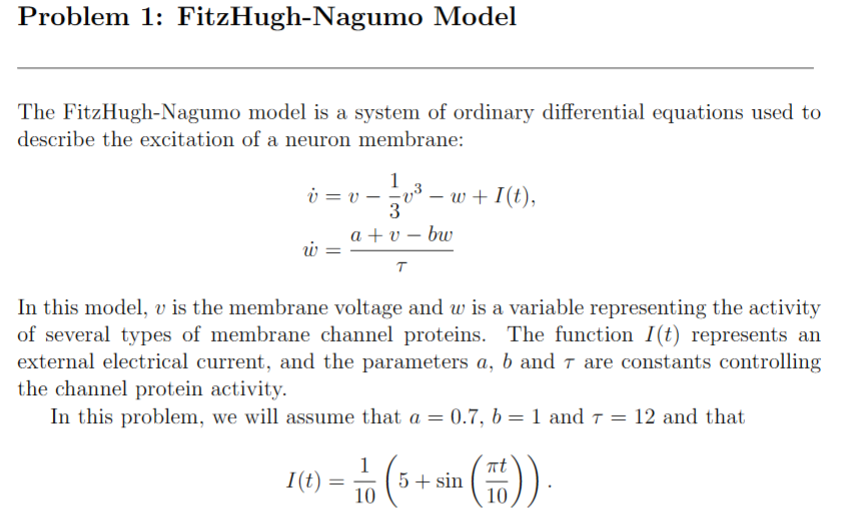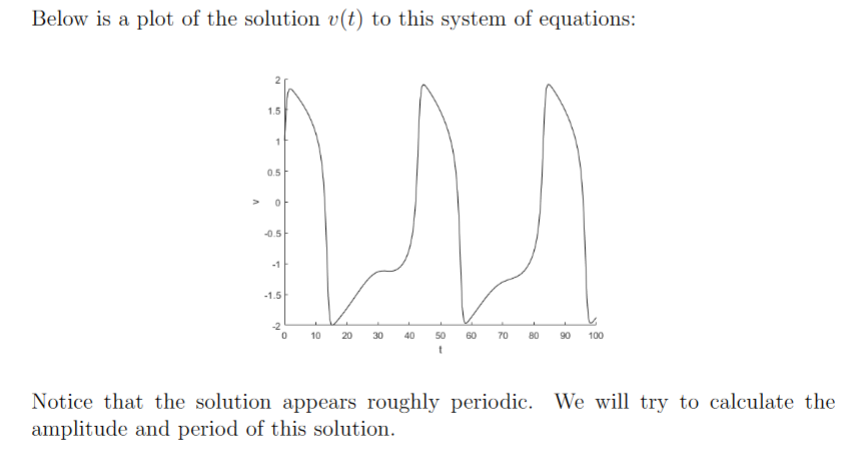Please help me understand this problem Write your code in matlab so i can follow.



Problem 1: FitzHugh-Nagumo Model The FitzHugh-Nagumo model is a system of ordinary differential equations used to describe the excitation of a neuron m , aubw In this model, is the membrane voltage and w is a variable representing the activity of several types of membrane channel proteins. The function I(t) represents an external electrical current, and the parameters a, b and are constants controlling the channel protein activity. In this problem, we will assume that a = 0.7, b = 1 and = 12 and that (f)-, (5 + sin ( )) 10 10 Below is a plot of the solution v(t) to this system of equations: 1.5 0.5 0.5 -1 1.5 -2 10 20 30 40 060 70 00 100 Notice that the solution appears roughly periodic. We will try to calculate the amplitude and period of this solution. (a) First, solve the equation from time t0 to timet 100 using a second order and Runge-Kutta method and At 0.5. Use the initial conditions(0) w(0) = 0, Save your approximation of the voltage at time 100 in A1. dat. b) Your approximation for v should have a local maximum at some time ti between t 0 and t 10, a local minimum at some time t2 between t 10 and t 20 and another local mxinn at snme time t4 and Find thes tim then calculate the amplitude of v, given by v(ti) - v(t2), and save it in A2.dat. Finally, calculate the period of v, given by t3 - t1, and save it in A3.dat. (You may find the max and min commands helpful. If you use these commands, do not use the 'all' option described in the help file; will not work in scorelator.) (e) Repeat part (a) using a fourth order Runge-Kutta method. Save your approxi- mation of the voltage at time 100 in A4.dat. (d) Repeat part (b) using your fourth order approximation for v. Save the amplitude in A5.dat and the period in A6.dat. Problem 1: FitzHugh-Nagumo Model The FitzHugh-Nagumo model is a system of ordinary differential equations used to describe the excitation of a neuron m , aubw In this model, is the membrane voltage and w is a variable representing the activity of several types of membrane channel proteins. The function I(t) represents an external electrical current, and the parameters a, b and are constants controlling the channel protein activity. In this problem, we will assume that a = 0.7, b = 1 and = 12 and that (f)-, (5 + sin ( )) 10 10 Below is a plot of the solution v(t) to this system of equations: 1.5 0.5 0.5 -1 1.5 -2 10 20 30 40 060 70 00 100 Notice that the solution appears roughly periodic. We will try to calculate the amplitude and period of this solution. (a) First, solve the equation from time t0 to timet 100 using a second order and Runge-Kutta method and At 0.5. Use the initial conditions(0) w(0) = 0, Save your approximation of the voltage at time 100 in A1. dat. b) Your approximation for v should have a local maximum at some time ti between t 0 and t 10, a local minimum at some time t2 between t 10 and t 20 and another local mxinn at snme time t4 and Find thes tim then calculate the amplitude of v, given by v(ti) - v(t2), and save it in A2.dat. Finally, calculate the period of v, given by t3 - t1, and save it in A3.dat. (You may find the max and min commands helpful. If you use these commands, do not use the 'all' option described in the help file; will not work in scorelator.) (e) Repeat part (a) using a fourth order Runge-Kutta method. Save your approxi- mation of the voltage at time 100 in A4.dat. (d) Repeat part (b) using your fourth order approximation for v. Save the amplitude in A5.dat and the period in A6.dat









